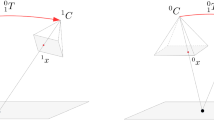Abstract
The inference speed of complex deep learning networks on embedded platforms of mobile robots is low, and it is difficult to meet actual application requirements, especially in complex environments such as the wild. This experiment out motion blur processing on the data set to improve the robustness, by using NVIDIA inference accelerator TensorRT to optimize the operation, the computational efficiency of the model is improved, and the inference acceleration of the deep learning model on the mobile quadruped robot platform is realized. The experimental results show that, on the test data set, the method achieves 91.67% mAP of 640 × 640 model on the embedded platform Nvidia Jetson Xavier NX. The reasoning speed is about 2.5 times faster than before, reaching 35 FPS, which provides support for the real-time application of mobile robot environment sensing ability in the field.
Access this chapter
Tax calculation will be finalised at checkout
Purchases are for personal use only
Similar content being viewed by others
References
Du, X., Cai, Y., Wang, S., et al.: Overview of deep learning. In: 2016 31st Youth Academic Annual Conference of Chinese Association of Automation (YAC), pp. 159–164. IEEE, (2016)
Ruan, J.: Design and implementation of target detection algorithm based on YOLO. Beijing University of Posts and Telecommunications, Beijing (2019). (In Chinese)
Tan, J.: Research on an improved YOLOv3 target recognition algorithm. Huazhong University of Science and Technology, Wuhan (2018). (In Chinese)
Yan, H.: Research on Static Image Target Detection Based on Deep Learning. North China Electric Power University, Beijing (2019). (In Chinese)
Liu, Y., et al.: Research on the use of YOLOv5 object detection algorithm in mask wearing recognition. World Sci. Res. J. 6(11), 276–284 (2020)
Rezatofighi, H., Tsoi, N., Gwak, J., Sadeghian, A., Reid, I., Savarese, S.: Generalized intersection over union: A metric and a loss for bounding box regression. In: The IEEE Conference on Computer Vision and Pattern Recognition (CVPR), pp. 658–666 (2019)
Zheng, Z., Wang, P., Liu, W., Li, J., Ye, R., Ren, D.: Distance-IoU loss: faster and better learning for bounding box regression. In: The AAAI Conference on Artifificial Intelligence (2020)
NVIDIA. NVIDIA Deep learning SDK[DB/OL]. Accessed 27 Nov 2019, https://docs.nvidia.com/deeplearning/sdk/index.html
Jian, Z., Zhao, D., Gao, W.: Group-based sparse representation for image restoration. IEEE Trans. Image Process. 23(8), 3336–3351 (2014)
Author information
Authors and Affiliations
Editor information
Editors and Affiliations
Rights and permissions
Copyright information
© 2021 Springer Nature Switzerland AG
About this paper
Cite this paper
Dai, B. et al. (2021). Field Robot Environment Sensing Technology Based on TensorRT. In: Liu, XJ., Nie, Z., Yu, J., Xie, F., Song, R. (eds) Intelligent Robotics and Applications. ICIRA 2021. Lecture Notes in Computer Science(), vol 13013. Springer, Cham. https://doi.org/10.1007/978-3-030-89095-7_36
Download citation
DOI: https://doi.org/10.1007/978-3-030-89095-7_36
Published:
Publisher Name: Springer, Cham
Print ISBN: 978-3-030-89094-0
Online ISBN: 978-3-030-89095-7
eBook Packages: Computer ScienceComputer Science (R0)




